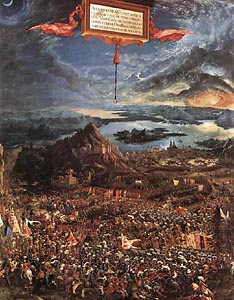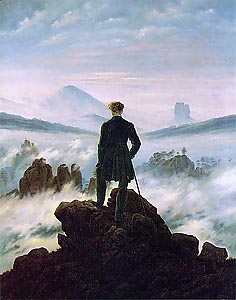| |
Heiner Altmeppen is a German artist residing
and
working
in Bremricherhof, Germany. His
oeuvre covers landscapes, still lifes and some figurative
work.

Traditions in
landscape painting in northern Europe trace back to the
German Renaissance painter Albrecht Altdorfer, whose most
recognized work is the Battle of Alexander, completed in 1529
(image to the right). This painting is unsurpassed in epic
scope and miniaturized detail. In the same period, the Flemish
painter Joachim Pantinir developed a panoramic
style utilizing unusual high vantage points. Pieter Bruegel
the Elder, a Flemish painter, also became interested in
panoramic landscapes, and adopted the aerial
perspective of Pantinir. His sons, Pieter Brueghel the Younger
and Jan Brueghel, produced significant paintings incorporating
majestic scenery. The work of these early artists incorporated
advances in both illusionism and naturalism, and helped
prepare a stage for the emergence of both genre painting and
landscapes in the Netherlands during the 17th century. Use of
the high perspective and of miniaturization can be seen in a
number of Heiner Altmeppen's paintings.
The word
landscape is based on a Dutch word, landschap. The
growth of the middle class in Calvinist Holland after 1620
allowed a large
%20by%20Jacob%20Isaakszoon%20van%20Ruysdael%201b.jpg) number
of artists to specialize in the landscape painting. Over the
next few decades, in what is referred to the tonal phase of
the Dutch Golden Age of art, atmospheric effects and realism.
Favorite subjects were river scenes or harbour scenes in which
the sky often dominated. The last half of the 17th century is
called the classical phase of the Golden Age, and during
this period there was an emphasis on dramatized lighting and
stronger color contrasts. Pictorial elements, such as a
windmill, a ruin, farm animals or boats were added as points
of interest. A notable artist during this time was
Jacob van Ruisdael. His favored subjects are woodland scenes, including
Nordic mountain streams, but he also painted seascapes and
cloudscapes (see image on right). In many ways his paintings
anticipates the landscapes of the Romantic period,
particularly the work of the Nordic artists. Inclusion of
dramatic skyscapes, seascapes and woodland scenes are
prevalent in Altmeppen's art. number
of artists to specialize in the landscape painting. Over the
next few decades, in what is referred to the tonal phase of
the Dutch Golden Age of art, atmospheric effects and realism.
Favorite subjects were river scenes or harbour scenes in which
the sky often dominated. The last half of the 17th century is
called the classical phase of the Golden Age, and during
this period there was an emphasis on dramatized lighting and
stronger color contrasts. Pictorial elements, such as a
windmill, a ruin, farm animals or boats were added as points
of interest. A notable artist during this time was
Jacob van Ruisdael. His favored subjects are woodland scenes, including
Nordic mountain streams, but he also painted seascapes and
cloudscapes (see image on right). In many ways his paintings
anticipates the landscapes of the Romantic period,
particularly the work of the Nordic artists. Inclusion of
dramatic skyscapes, seascapes and woodland scenes are
prevalent in Altmeppen's art.
In the Romantic landscape, which emerged in the early 19th
century, the predominate themes revolved around the majestic
beauty and awesome
 power
of nature. These themes are evident in the works of
Caspar David Friedrich
(1774-1840), who trained at the Royal Danish Academy of
Fine Art in
Copenhagen. He was influenced by his teachers Christian August Lorentzen and
Jens Juel.
In his work Friedrich combined accurate depictions of the
natural world with personal insight, often with an allegorical
meaning. His art was all about evoking a mood. It is clear
that a contemplative aspect pervades Altmeppen's art.
Additionally, his paintings exhibits a rich palette that was
typical of many other Romantic artists, as seen in the
paintings by
J.M.W. Turner
and Theodore Chasseriau. Thematically the inclusion of ruins
or decrepit elements was typical of Romantic landscapes. There
is no question that Heiner Altmeppen's paintings are informed
by the spirit of Romantic art. Yet to characterize his art as
a type of Neo Romanticism would be misleading. The apparent
influences are far more complex. power
of nature. These themes are evident in the works of
Caspar David Friedrich
(1774-1840), who trained at the Royal Danish Academy of
Fine Art in
Copenhagen. He was influenced by his teachers Christian August Lorentzen and
Jens Juel.
In his work Friedrich combined accurate depictions of the
natural world with personal insight, often with an allegorical
meaning. His art was all about evoking a mood. It is clear
that a contemplative aspect pervades Altmeppen's art.
Additionally, his paintings exhibits a rich palette that was
typical of many other Romantic artists, as seen in the
paintings by
J.M.W. Turner
and Theodore Chasseriau. Thematically the inclusion of ruins
or decrepit elements was typical of Romantic landscapes. There
is no question that Heiner Altmeppen's paintings are informed
by the spirit of Romantic art. Yet to characterize his art as
a type of Neo Romanticism would be misleading. The apparent
influences are far more complex.
Some significant aspects of Heiner Altmeppen's art arise from
the subtle influence of Neue Sachlichkeit. In many of his
paintings there is a stillness, akin to the static, airless
environment often encountered in the paintings of German art
in the 1920s. Secondly, many paintings exhibit a
precise, sharply defined Realism often encountered in the
still lifes and landscapes of this same period. And finally,
the mood of many of Altmeppen's paintings is akin to the eerie
atmospheres that are so typical experienced in works by
Franz Radziwill and other Magic Realist artists.
Heiner Altmeppen's
Gallery
Artist's Web Site:
http://www.heiner-altmeppen.de
|
|